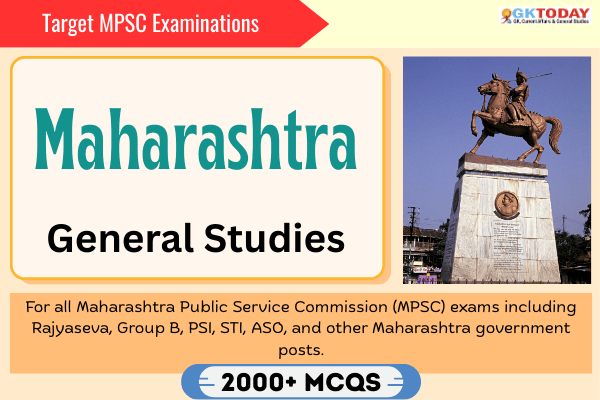States PCS: Maharashtra GK Questions for MPSC Examinations
For all Maharashtra Public Service Commission (MPSC) exams including Rajyaseva, Group B, PSI, STI, ASO, and other Maharashtra government posts.
41. Which Hindu saint, devotee of Vithoba, was a contemporary of Namdev?
[A] Savata Mali
[B] Eknath
[C] Tukaram
[D] Dnyaneshwar
Show Answer
Correct Answer: A [Savata Mali]
Notes:
Savata Mali was a 12th-century saint and Vithoba devotee from Maharashtra, contemporary to Namdev. Born in 1250 in Solapur district to a poor Bhagwat family, he sang devotional songs while farming. Temples dedicated to Savata Mali exist in Maharashtra, notably in Aran village.
42. Who became the youngest IAS officer in India?
[A] Ansar Shaikh
[B] Roman Saini
[C] Namrata Jain
[D] Shruti Sharma
Show Answer
Correct Answer: A [Ansar Shaikh]
Notes:
Ansar Shaikh, from Maharashtra, cleared UPSC at age 21 in 2016. He joined the West Bengal cadre, making him the youngest IAS officer in India. He graduated from Fergusson College, Pune, and his background was humble, being the son of an autorickshaw driver and farm worker.
43. Which Harvard professor pioneered the security games used in airport security?
[A] Partha Dasgupta
[B] Subhash Khot
[C] Sendhil Mullainathan
[D] Milind Tambe
Show Answer
Correct Answer: D [Milind Tambe]
Notes:
Milind Tambe pioneered the security games framework used in airport security, notably first deployed at LAX. He is a Harvard professor, director at Google Research India, globally recognized for AI for social good, and recipient of notable AI and computer science awards.
44. Which Maratha clan was established by Ranoji Scindia?
[A] Gaekwad
[B] Shinde (Scindia)
[C] Holkar
[D] Bhosale
Show Answer
Correct Answer: B [Shinde (Scindia)]
Notes:
Shinde (Scindia) clan was founded by Ranoji Scindia, who served Peshwa Bajirao I. The Scindias became prominent rulers of Gwalior. This Maratha clan is found mainly in Maharashtra, Madhya Pradesh, and neighboring states.
45. Which entrance exam is needed for Government Medical College, Gondia admission?
[A] MHT-CET
[B] AIIMS Entrance
[C] JIPMER Entrance
[D] NEET
Show Answer
Correct Answer: D [NEET]
Notes:
Admission to Government Medical College, Gondia, Maharashtra is through NEET, as mandated by the National Medical Commission. The college offers MBBS with 150 seats. NEET is the qualifying exam for most medical colleges in India, including those in Maharashtra.
46. Which is the second education board in Maharashtra for Marathi medium schools?
[A] Maharashtra State Board of Secondary and Higher Secondary Education
[B] Maharashtra International Education Board
[C] Maharashtra Open School Board
[D] Maharashtra Technical Education Board
Show Answer
Correct Answer: B [Maharashtra International Education Board]
Notes:
Maharashtra International Education Board (MIEB) was set up in 2018 by Maharashtra government as the second board to promote high-quality Marathi medium education equivalent to international standards. It was eventually merged with the State Board in 2020.
47. Who witnessed the miracle of Muktabai baking food on Jñāneśvar’s heated back?
[A] Namdev
[B] Muktabai
[C] Jñāneśvar
[D] Visoba Khechara
Show Answer
Correct Answer: D [Visoba Khechara]
Notes:
Visoba Khechara was a contemporary of Jñāneśvar, Muktabai, and Namdev, all prominent saints from Maharashtra. Initially skeptical of the siblings’ spiritual powers, Visoba’s doubts were dispelled after he personally witnessed the miracle in which Muktabai baked food on Jñāneśvar’s heated back. This profound event led to Visoba’s transformation and deeper involvement with the Bhakti movement. He later became the guru of Namdev and promoted a blend of Shaiva philosophy and Vithoba worship.
48. Who controversially married an 11-year-old despite advocating widow remarriage?
[A] Gopal Krishna Gokhale
[B] Jyotirao Phule
[C] Bal Gangadhar Tilak
[D] Mahadev Govind Ranade
Show Answer
Correct Answer: D [Mahadev Govind Ranade]
Notes:
Mahadev Govind Ranade was a pioneering social reformer from Maharashtra who strongly advocated widow remarriage and female education. Despite his progressive stance, he controversially married an 11-year-old girl named Ramabai. This event is notable because it contrasted with his reformist ideals and sparked debate at the time. Ranade’s efforts led to significant social changes in Maharashtra, including opposition to child marriage and caste restrictions. His legacy remains influential among Maharashtra’s reformist leaders like Gokhale, Tilak, and Phule.
49. Who produced Somnath Waghmare’s documentary Chaityabhumi on Ambedkar’s birth anniversary?
[A] Smita Rajmane
[B] Pa. Ranjith
[C] Gail Omvedt
[D] Bharat Patankar
Show Answer
Correct Answer: B [Pa. Ranjith]
Notes:
Chaityabhumi is a documentary by Somnath Waghmare that focuses on Dr. B.R. Ambedkar. The documentary was produced by Pa. Ranjith’s Neelam Productions. Pa. Ranjith, originally from Tamil Nadu, is celebrated for championing Dalit issues through cinema. His production of this Marathi documentary signifies strong cross-regional support within Dalit activism. The film has garnered international attention, being screened at renowned institutions such as LSE and Columbia University, and found a wider audience through its release on MUBI on Ambedkar’s birth anniversary.
50. Who built the Gowri Mahal and commissioned gardens in Bangalore during the 17th century?
[A] Shahaji Bhonsale
[B] Shivaji Maharaj
[C] Sambhaji II of Kolhapur
[D] Dadoji Kondadev
Show Answer
Correct Answer: A [Shahaji Bhonsale]
Notes:
Shahaji Bhonsale, a prominent Maratha noble, constructed the Gowri Mahal and commissioned gardens in Bangalore after receiving the Bangalore jagir from the Bijapur Sultanate in 1638. He made Bangalore his headquarters, marking an important expansion of Maratha power in South India during turbulent Deccan politics. Shahaji was not only a skilled warrior but also an able administrator who introduced Pune Brahmins to oversee governance and appointed Dadoji Kondadev to manage Pune jagirs, thereby consolidating Maratha influence beyond Maharashtra. His contributions set the foundation for future Maratha rule in southern regions.

